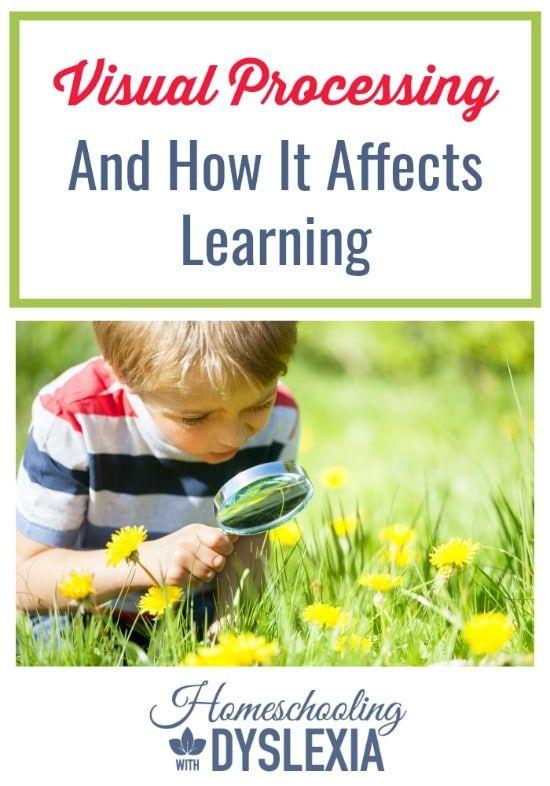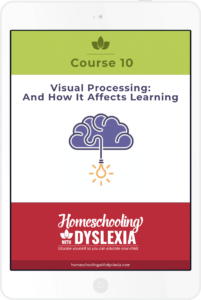Does your child think that a square and a circle look the same? Does he bump into things, spill things, or seem unaware of where objects are in relation to his body? Does he skip words or entire lines when reading, or read the same sentence over? All of these issues can be signs of a visual processing weakness (sometimes referred to as Visual Processing Disorder) which can have a dramatic affect on learning.

Visual Processing Disorder (VPD) refers to a variety of vision issues that have nothing to do with nearsightedness or farsightedness.
In VPD, the brain has trouble accurately processing signals that come from the eyes.
A child with VPD may pass her vision test with flying colors because her eyes are fine. The problem is the way her brain deals with or processes visual information.
Symptoms or Signs of Visual Processing Issues
Not all kids will have all of these signs. Like auditory processing, there are a variety of areas of weakness and all kids will be affected by different types of weakness and to different degrees.
- Is easily distracted by too much visual information.
- Can be restless or inattentive during video or visual presentations
- May do a sloppy job with visual tasks, for instance, sweeping the floor – these are not the kids you ask to do a quick clean up when unexpected company are coming!
- Has difficulty with tasks that require copying (taking notes from a board)
- Reverses or misreads letters, numbers and words
- Frequently bumps into things
- Has difficulty writing within lines or margins
- Skips words or entire lines when reading, or reads the same sentence over
- Says his eyes hurt, rubs his eyes a lot when reading, writing or drawing
- Has below-average reading comprehension and writing skills, despite strong oral (spoken) comprehension and verbal skills
- Has weak math skills; frequently ignores function signs, omits steps, and confuses visually similar formulas
Visual Processing and Dyslexia
Like Auditory Processing, visual processing issues aren’t a recognized learning disability on their own. The symptoms do, however, often appear in kids with reading, writing and math struggles.
Many experts believe visual processing issues are risk factors for learning issues such as dyslexia, however, the lines between where processing, dyslexia, dysgraphia, and dyscalculia meet are blurred.
As parents and teachers, it is enough to know that these weaknesses come together in many of our kids. Auditory processing, visual processing, weak working memory and weak executive function skills are at the root of many of our kids’ learning difficulties.
Overcoming Visual Processing Disorder
Overcoming visual processing weaknesses involves two paths: remediation and accommodation.
- Accommodations offer supports to areas of weakness so that the visual pathways aren’t overloaded.
- Remediations are programs and activities that strengthen visual processing.
Accommodations for Students With Visual Processing Weakness or Disorder
Some of the most helpful accommodations for kids with visual processing weakness are:
- Don’t rely solely on the visual instructions. Give oral directions as well as written directions.
- Include simple diagrams or images to help clarify long written directions. We also use cheat sheet for math that outline procedures for more complicated problems.
- Allow time for your child to ask questions about presentations and directions. This may seem obvious but allowing time for processing and making it okay to not get it all the first time is going to make a more conducive environment for learning.
- Find curriculum with uncluttered pages and simple directions It’s amazing how much of a difference page layout can make for visually weak students. While we may be drawn to a colorful math curriculum with lots of images, it might be too distracting for some kids.
- Draw a bold, black borders around math problems to help the student focus on one item at a time.
- Ask for oral reports instead of written responses.
- Use audiobooks and tape class lectures.
- Reduce visual distractions by folding a worksheet OR using blank pieces of paper to cover up part of the page.
Activities for Strengthening Visual Processing Skills
Strengthening visual processing skills can be done at home, inexpensively with items you probably already own. Some examples of these activities are:
- Sorting objects first by one attribute (size, color, or shape)
- Sorting by 2 and more attributes
- Completing puzzles beginning with simple puzzles and moving up to more complex
- Completing letter, number, or word searches
- Play “I Spy” games (i.e. I see something red and round)
- Hidden picture type puzzles
- Make patterns with beads, small toys or household objects and have your child copy them
- Place several items on a tray in order, cover it up and mix the items up. See if your child can remember to put them in the correct order.
- Play store bought memory games like Simon, Mastermind or Loopz.
- Practice, practice, practice balls skills – catching, throwing, kicking and hitting. Start with large balls and slower speeds and progress to smaller balls and faster speeds.
- Make your own memory games. Place several objects on a tray. Let your child look at the objects for 1-2 minutes. Cover the objects up with a towel. See how many objects he or she can remember from the tray without looking.
- Play board games that require you to move your pieces in certain directions such as checkers or chess.
- Complete multi-step craft activities such as origami.
- Find a simple picture in a magazine and fold it in half. Glue it on a piece of paper. See if your child can finish drawing the other side of the picture.
As you can see, there are a lot of simple (and fun) activities that you can do in 10-15 minutes per day to work on your kids’ visual processing weaknesses.
Learn More About Visual Processing and How it Affects Learning
Learn more about visual processing weaknesses: how to recognize it in your kids and more importantly, how to improve processing speeds at home.

In this online parent course you will learn:
- To understand what processing issues are
- The definition of Visual Processing Disorder
- The 8 areas of visual processing weakness that impact Visual Processing Disorder
- How to know if your child’s issues are vision-based or a processing issue
- How to get a diagnosis
- Symptoms and Signs of visual processing issues
- Treatments for Visual Processing Disorder
- Types of therapies and interventions to help kids with visual processing weaknesses
- Tons of activities for building visual processing skills
- Best accommodations for kids with Visual Processing Disorder
- Best assistive technology for Visual Processing Disorder
Visit our Course Page for more information or our Shop to purchase.






Hello!
I am constantly looking for more information and therapies/activities for VPD. Our son has never been diagnosed with VPD even though we went through all of the typical testing IQ, Academic, etc. Basically we were told he had a low IQ, even though some other professionals read the report and said for sure he has a reading disability.
We thought our son might be dyslexic, but there were so many things that didn’t line up with “dyslexia” which led us to looking into VDP and eventually Vision Therapy. He was “diagnosed” with a very slow visual processing speed, convergence insufficiency, tracking and focusing issues. We just completed 8 months of vision therapy with our son. He turned 9 years old at the end of the program. His CI, Tracking, and Focusing are much improved now….
Prior to starting the program he was reading on possibly a K level at best and struggled so much with sight words and math facts did not stick, now while not reading as fluently as I would like, he is able to read books that are closer to 3rd grade reading level and finishing up Math U See Beta, well before our school year is over.
Reading, writing, and math are still hard work, and spelling is not good at all and he tires out easily. I am trying to figure out the balance of knowing when to push him beyond his level of comfort and backing off because it is just too much for the day.
While vision therapy corrected/improved many issues… I know there are still some skills that are really not clicking and I am still trying to figure out how to improve those – writing, fine motor skills, problem solving, visual spatial skills as well.
I will be looking into the course you will be releasing!
Thank you.
This describes my 7 year old daughter quite well and the accomodations suggested work for her. We did undergo vision therapy which she completed last January and presently she is receiving OT for the handwriting, fine motor skills, etc. Prior to learning about VPD, we were already aware she had a condition known as accomodative esotropia. Not all eye doctors are created equal. It took a number of doctors to finally get her diagnosed. After she was diagnosed, it took 3 doctors to get her someone who would do something beyond just glasses for her. Vision therapy was wonderful with huge improvements noted despite the fact that our insurance refused to cover it and we ended up paying for it entirely out of pocket. Insurance said it was experimental and would not cover vision therapy for my daughter’s specific diagnosis. All I know, is insurance has no clue what they are talking about and vision therapy was a tremendous help for my child. Now we are trying to play catch up. She is testing at an average IQ but talks well above that so I question the accuracy of the IQ test for her. All I know is it seems if she hears it once, it sticks. She has movies, stories, and songs memorized only after a couple times hearing them. The more audio we can use for teaching her, the more excited she gets about learning.
Testing isn’t always accurate. And it certainly doesn’t test for many of the strengths our outside the box learners have.
It can be frustrating for sure, but I love hearing how you have advocated and fight for your child!